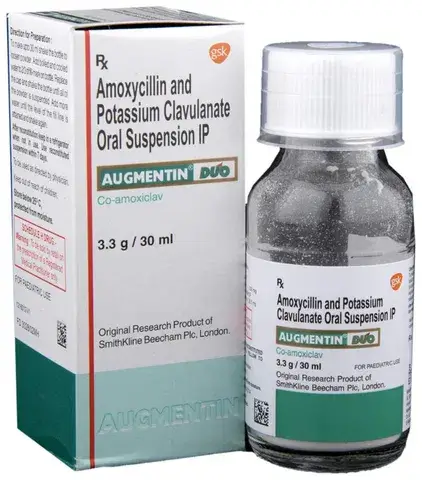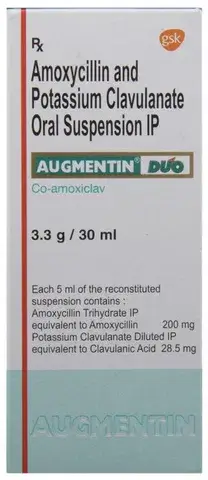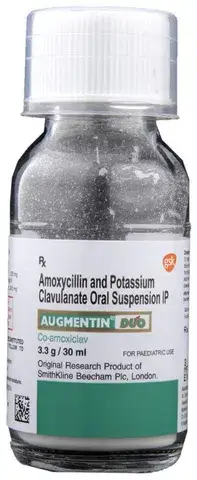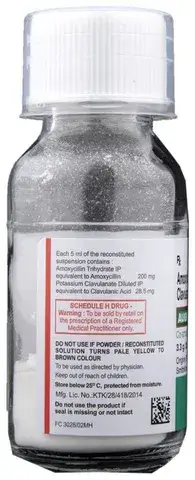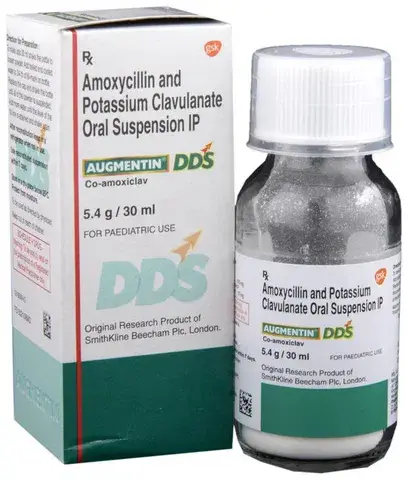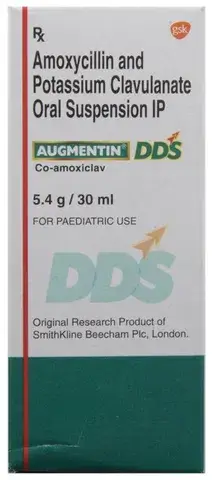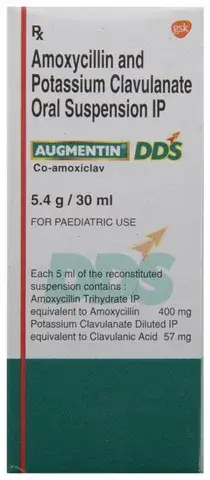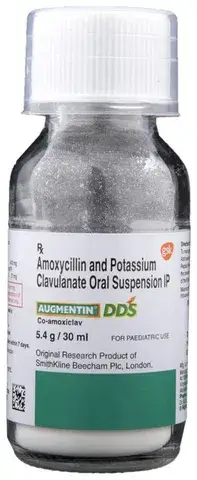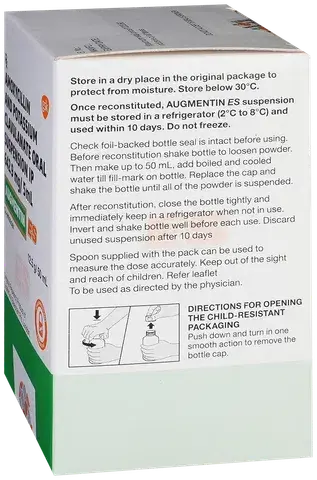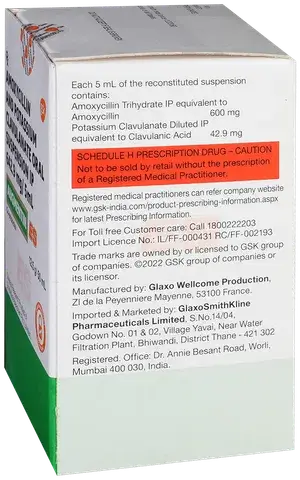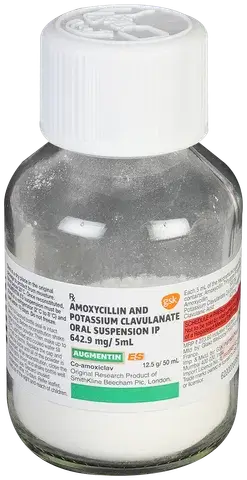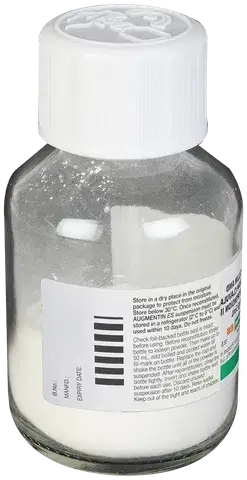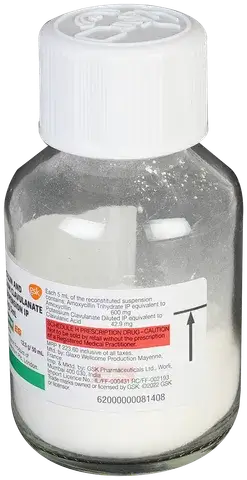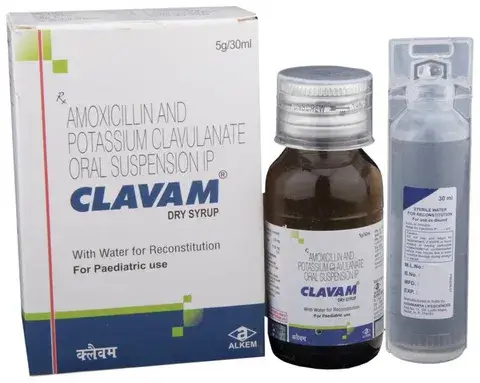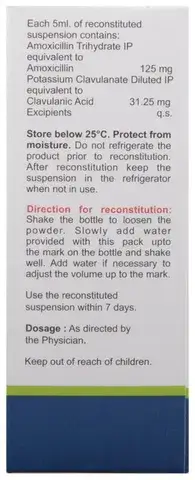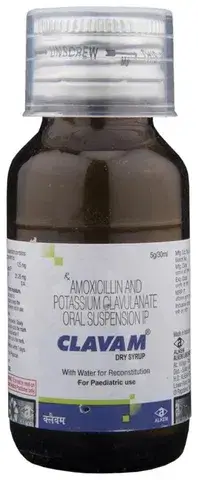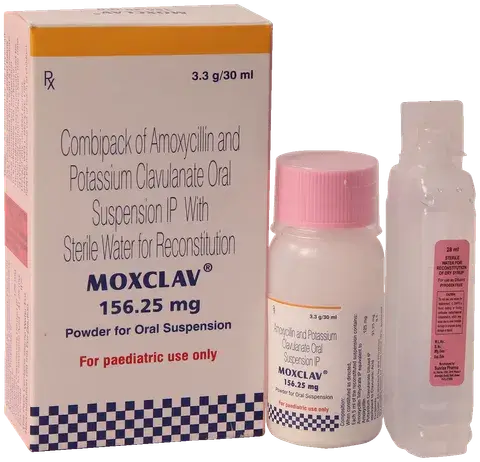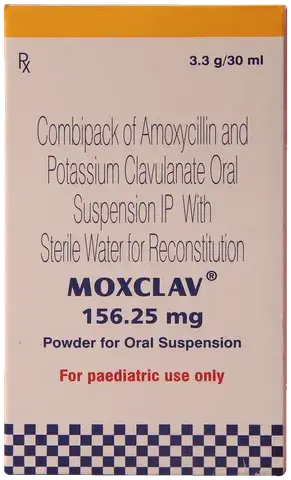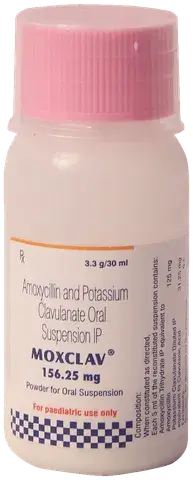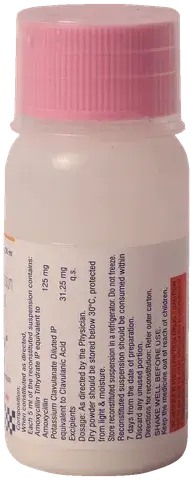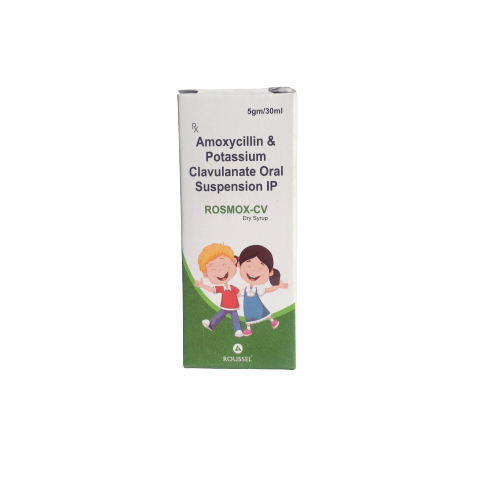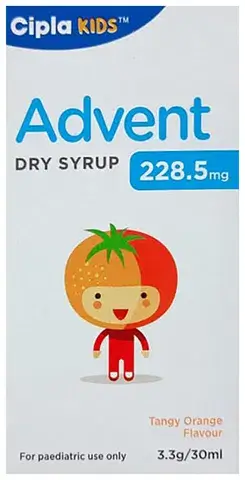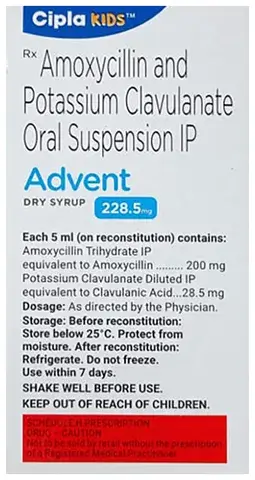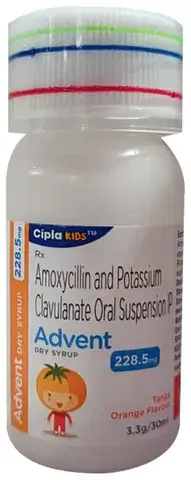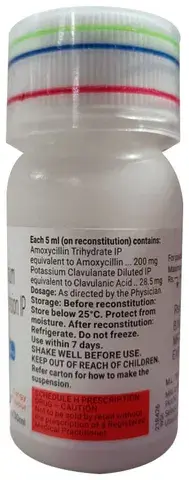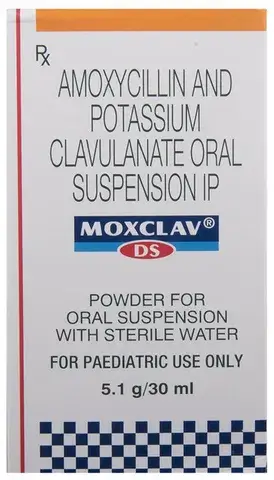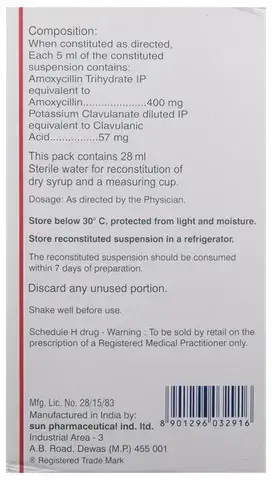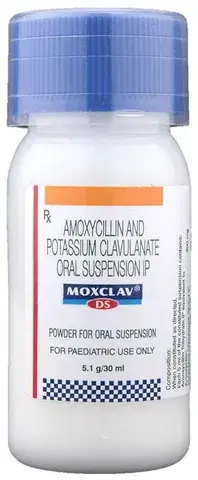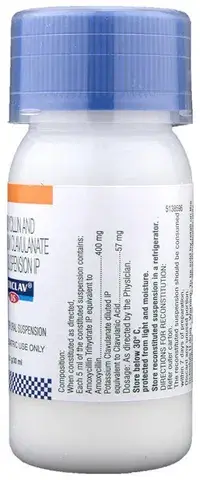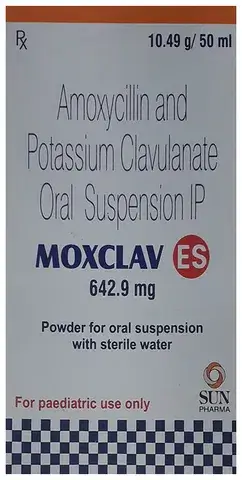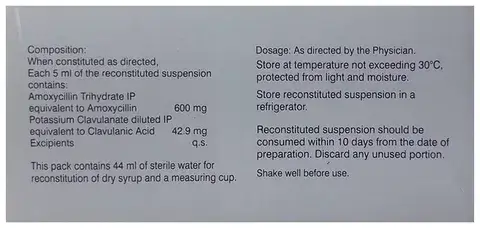Augmentin (Amoxicillin + Clavulanate) Oral Suspension
Branded
Augmentin
Augmentin
Augmentin
Generic
Amoxicillin + Clavulanate (Generic Equivalent to Augmentin)
Amoxicillin + Clavulanate (Generic Equivalent to Augmentin)
Amoxicillin + Clavulanate (Generic Equivalent to Augmentin)
Amoxicillin + Clavulanate (Generic Equivalent to Augmentin)
Amoxicillin + Clavulanate (Generic Equivalent to Augmentin)
Amoxicillin + Clavulanate (Generic Equivalent to Augmentin)
Amoxicillin + Clavulanate (Generic Equivalent to Augmentin)
Augmentin Oral Suspension is an antibiotic medicine that helps treat bacterial infections of the ear, nose, throat, chest, lungs, teeth, skin, and urinary tract. It is capable of killing bacteria that have become resistant to other therapies and thus also helps treat tuberculosis that is resistant to other treatments.
You can give Augmentin Oral Suspension to your child with or without food. It is better to give it with food as that helps increase absorption and decrease the risk of stomach upset. The doctor may prescribe giving it two to three times a day. Medicine dose depends on the severity of the infection, its type, and your child’s body weight and age. So, stick to the dose, time, and way prescribed. If your child vomits the medicine within 30 minutes of intake, let the child calm down and repeat the dose. Do not double dose if it’s the time for the next dose.
Augmentin Oral Suspension may cause vomiting, diarrhea, nausea, abdominal pain, and allergy. These side effects should diminish on their own. But, in case they persist or start bothering your child, you must not delay speaking to your child’s doctor.
Share your child’s entire medical history with the doctor, including any previous episode of allergy, heart problem, a blood disorder, birth defects, airway obstruction, lung anomaly, gastrointestinal problem, skin disorder, liver impairment, and kidney malfunction. This information will assist the doctor in making dose alterations and in planning your child’s overall treatment.
Uses Of Augmentin Oral Suspension In Children
- Treatment of Resistance Tuberculosis (TB)
- Treatment of Bacterial infections
Benefits Of Augmentin Oral Suspension For Your Child
In Treatment Of Resistance Tuberculosis (TB)
In multidrug-resistant (MDR) tuberculosis, the causative bacteria produce an enzyme called beta-lactamase. This enzyme breaks down the antibiotics and makes them ineffective. As a result, the bacteria become resistant to the antibiotic being used for treatment. Augmentin Oral Suspension comprises two active ingredients, amoxycillin and clavulanic acid. While clavulanic acid stops the enzyme from rendering amoxycillin ineffective, amoxycillin works towards killing the tuberculosis-causing bacteria. This makes the combination of amoxycillin and clavulanic acid an effective treatment for resistant tuberculosis.
In Treatment Of Bacterial Infections
Augmentin Oral Suspension contains two different medicines, Amoxycillin and Clavulanic Acid, that work together to kill the bacteria that cause infections. Amoxycillin works by stopping the growth of bacteria. Clavulanic Acid reduces resistance and enhances the activity of Amoxycillin against bacteria.
This combination medicine can be used to treat many different bacterial infections such as ear, sinus, throat, lung, urinary tract, skin, teeth, joints, and bones. It usually makes you feel better within a few days, but you should continue taking it as prescribed even when you feel better to make sure that all bacteria are killed and do not become resistant.
Side Effects Of Augmentin Oral Suspension In Children
Augmentin Oral Suspension does not pose serious side effects and is well-tolerated by children. In case the side effects do occur, they’re likely to subside once the body adapts to the medicine. Consult your child’s doctor if these side effects persist or bother your child.
Common Side Effects Of Augmentin
- Nausea
- Vomiting
- Abdominal pain
- Diarrhea
- Allergy
- Skin rash
How Can I Give Augmentin Oral Suspension To My Child
Take this medicine in the dose and duration as advised by your doctor. Check the label for directions before use. Measure it with a measuring cup and take it by mouth. Shake well before use. Augmentin Duo Oral Suspension is to be taken with food.
How Augmentin Oral Suspension Works
Augmentin Oral Suspension is an antibiotic. It has two active agents, amoxycillin and clavulanic acid. Amoxycillin works by preventing the formation of the bacterial protective covering (cell wall) essential for the survival of the bacteria. Whereas, clavulanic acid serves a special purpose of inhibiting an enzyme (beta-lactamase) that is produced by resistant bacteria. This makes the combination of amoxycillin and clavulanic acid an effective line of treatment for many types of infections.
Disclaimer :The information provided on the website is intended to facilitate awareness about healthcare products and medical conditions generally but it is not a substitute for professional medical attention or advice. You should always speak with a qualified healthcare practitioner before taking any prescription or non-prescription drug. |
| Product Type--Salt | Generic–Amoxicillin + Clavulanate (Generic Equivalent to Augmentin), Brands–Augmentin |
|---|---|
| tag--Manufacturer | Best Selling–Athens Lifescience, Top Brand–Cipla, Branded–GlaxoSmithkline Pharmaceuticals, Best Selling–Alkem Laboratories, Top Brand–Sun Pharmaceutical, Best Selling–Leeford, Top Brand–Sun Pharmaceutical, Branded–GlaxoSmithkline Pharmaceuticals, Top Brand–Sun Pharmaceutical, Branded–GlaxoSmithkline Pharmaceuticals |
| Power--Pack Size | (200mg + 28.5mg)/5ml–30ml in 1 Bottle (1 Bottle), (200mg + 28.5mg)/5ml–30ml in 1 Bottle (2 Bottles), (200mg + 28.5mg)/5ml–30ml in 1 Bottle (4 Bottles), (200mg + 28.5mg)/5ml–30ml in 1 Bottle (6 Bottles), (200mg + 28.5mg)/5ml–30ml in 1 Bottle (1 Bottle), (200mg + 28.5mg)/5ml–30ml in 1 Bottle (2 Bottles), (200mg + 28.5mg)/5ml–30ml in 1 Bottle (4 Bottles), (200mg + 28.5mg)/5ml–30ml in 1 Bottle (6 Bottles), (200mg + 28.5mg)/5ml–30ml in 1 Bottle (1 Bottle), (200mg + 28.5mg)/5ml–30ml in 1 Bottle (2 Bottles), (200mg + 28.5mg)/5ml–30ml in 1 Bottle (4 Bottles), (200mg + 28.5mg)/5ml–30ml in 1 Bottle (6 Bottles), (125mg + 31.25mg)/5ml–30ml in 1 Bottle (1 Bottle), (125mg + 31.25mg)/5ml–30ml in 1 Bottle (2 Bottles), (125mg + 31.25mg)/5ml–30ml in 1 Bottle (4 Bottles), (125mg + 31.25mg)/5ml–30ml in 1 Bottle (6 Bottles), (125mg + 31.25mg)/5ml–30ml in 1 Bottle (1 Bottle), (125mg + 31.25mg)/5ml–30ml in 1 Bottle (2 Bottles), (125mg + 31.25mg)/5ml–30ml in 1 Bottle (4 Bottles), (125mg + 31.25mg)/5ml–30ml in 1 Bottle (6 Bottles), (400mg + 57mg)/5ml–30ml in 1 Bottle (1 Bottle), (400mg + 57mg)/5ml–30ml in 1 Bottle (2 Bottles), (400mg + 57mg)/5ml–30ml in 1 Bottle (4 Bottles), (400mg + 57mg)/5ml–30ml in 1 Bottle (6 Bottles), (400mg + 57mg)/5ml–30ml in 1 Bottle (1 Bottle), (400mg + 57mg)/5ml–30ml in 1 Bottle (2 Bottles), (400mg + 57mg)/5ml–30ml in 1 Bottle (4 Bottles), (400mg + 57mg)/5ml–30ml in 1 Bottle (6 Bottles), (400mg + 57mg)/5ml–30ml in 1 Bottle (1 Bottle), (400mg + 57mg)/5ml–30ml in 1 Bottle (2 Bottles), (400mg + 57mg)/5ml–30ml in 1 Bottle (4 Bottles), (400mg + 57mg)/5ml–30ml in 1 Bottle (6 Bottles), (600mg + 42.9mg)/5ml–50ml in 1 Bottle (1 Bottle), (600mg + 42.9mg)/5ml–50ml in 1 Bottle (2 Bottles), (600mg + 42.9mg)/5ml–50ml in 1 Bottle (6 Bottles), (600mg + 42.9mg)/5ml–50ml in 1 Bottle (4 Bottles), (600mg + 42.9mg)/5ml–50ml in 1 Bottle (1 Bottle), (600mg + 42.9mg)/5ml–50ml in 1 Bottle (2 Bottles), (600mg + 42.9mg)/5ml–50ml in 1 Bottle (4 Bottles), (600mg + 42.9mg)/5ml–50ml in 1 Bottle (6 Bottles) |

